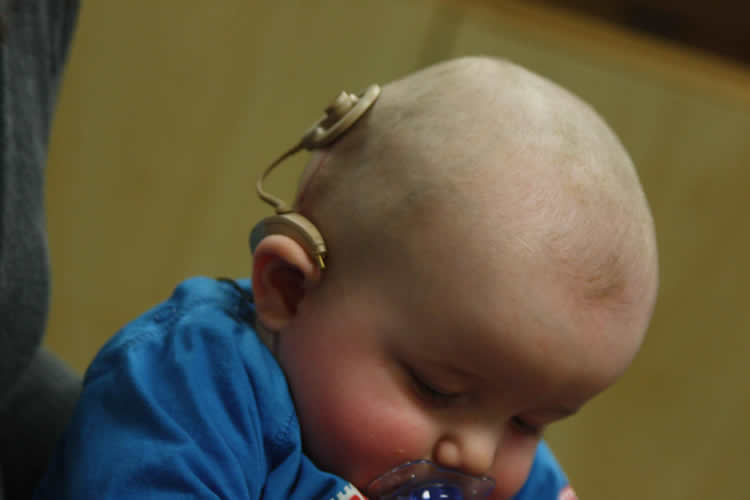Infants are motivated by hearing themselves.
‘Dada’ is a first word for many babies. Babbling sounds with consonant-vowel repetitions, such as ‘dada,’ are common among infants once they reach 8 months old; however, these sounds are not prevalent among infants who have profound hearing loss — that is, until they receive cochlear implants. Now, University of Missouri research shows that babies’ repetitive babbles primarily are motivated by infants’ ability to hear themselves. Additionally, infants with profound hearing loss who received cochlear implants to improve their hearing soon babbled as often as their hearing peers, allowing them to catch up developmentally.
“Hearing is a critical aspect of infants’ motivation to make early sounds,” said Mary Fagan, an assistant professor of communication science and disorders in the MU School of Health Professions. “The fact that they attend to and learn from their own behaviors, especially in speech, highlights how infants’ own experiences help their language, social and cognitive development. This research doesn’t diminish the importance of the speech that babies hear from others — we know they need to learn from others — but it raises our awareness that infants are not just passive recipients of what others say to them. They are actively engaged in their own developmental process.”
Fagan studied the babbles of 27 hearing infants and 16 infants with profound hearing loss before and after they received cochlear implants, which are small electronic devices embedded into the bone behind the ear that replace some functions of the damaged inner ear. Before receiving cochlear implants, babies with profound hearing loss rarely produced repetitive vocalizations, such as ‘ba-ba’ or ‘da-da.’ Within a few months of receiving cochlear implants, the number of babies who produced repetitive vocalizations increased, the number of vocalizations that contained repetitive syllables increased, and the number of actual repetitions in the string, such as ‘ba-ba-ba-ba-ba,’ increased, Fagan said.
“The research tells us that infants are motivated by hearing the sounds they produce, so these sounds are functional in some way,” Fagan said. “Research conducted by others supports the idea that babies form mental representations of their own babbles, such as these strings of syllables, which may be the reason that infants tend to use the sounds that they have babbled in their first words rather than the sounds that are most common in the speech that adults use with them.”

Fagan says parents who have children with profound hearing loss should be well-informed about cochlear implants before making the decision for their children to get the devices.
“Many parents elect to have their children with profound hearing loss receive cochlear implants, and that’s a decision parents alone can make,” Fagan said. “Whatever decision the parents make, the data strongly show that if parents are going to choose a cochlear implant, the sooner the better. Studies like mine show how rapidly babies with hearing loss respond to cochlear implants, often minimizing the impact on their speech, language and vocabulary development.”
Funding: The National Institutes of Health provided funding for this study (T32DC00012; David Pisoni PI), as did grants from the American Speech-Language-Hearing Foundation and Acoustical Society of America. The content is solely the responsibility of the authors and does not necessarily represent the official views of the funding agencies.
Source: Jesslyn Chew – University of Missouri-Columbia
Image Credit: The image is credited to Bjorn Knetsch
Original Research: Abstract for “Why repetition? Repetitive babbling, auditory feedback, and cochlear implantation” by Mary K. Fagan in Journal of Experimental Child Psychology. Published online May 15 2015 doi:10.1016/j.jecp.2015.04.005
Abstract
Why repetition? Repetitive babbling, auditory feedback, and cochlear implantation
his study investigated the reduplicated, or repetitive vocalizations of hearing infants and infants with profound hearing loss with and without cochlear implants using a new measure of repetition in order to address questions not only about the effects of cochlear implantation on repetitive babbling, but also about the reason repetitive vocalizations occur at all and why they emerge around 7 or 8 months of age in hearing infants. Participants were 16 infants with profound hearing loss and 27 hearing infants who participated at a mean age of 9.9 months and/or a mean age of 17.7 months. Mean age at cochlear implantation for infants with profound hearing loss was 12.9 months, and mean duration of implant use was 4.2 months. The data show that before cochlear implantation, repetitive vocalizations were rare. However, 4 months after cochlear implant activation, infants with hearing loss produced both repetitive vocalizations and repetitions per vocalization at levels commensurate with their hearing peers. The results support the hypothesis that repetition emerges as a means of vocal exploration during the time when hearing infants (and infants with cochlear implants) form auditory–motor representations and neural connections between cortical areas active in syllable production and syllable perception, during the transition from nonlinguistic to linguistic vocalization.
“Why repetition? Repetitive babbling, auditory feedback, and cochlear implantation” by Mary K. Fagan in Journal of Experimental Child Psychology. Published online May 15 2015 doi:10.1016/j.jecp.2015.04.005






